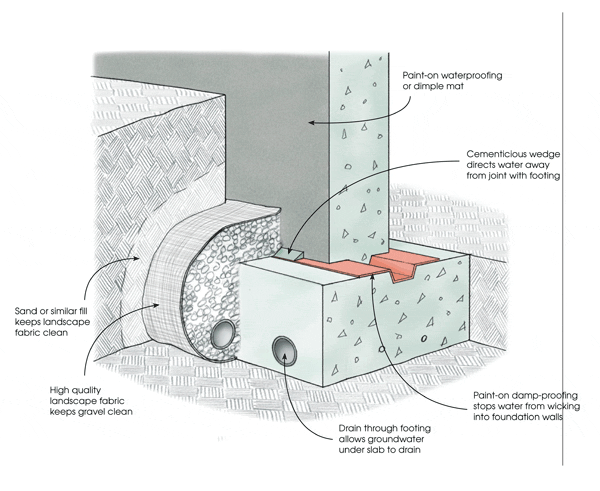ABOUT FOUNDATIONS
Foundations should be well insulated and keep water at bay
Depending on where you’re building, a conventional foundation could be made from poured concrete, brick, block, or stone. Because the foundation is buffered by the earth, temperature swings are less extreme than at the roof, but moisture issues are very important: Every drop of water that hits the roof and walls runs off to the ground.
Footing drains help a foundation stave off groundwater. And foundations also have to disrupt capillarity, the tendency of concrete walls and floors to wick water inside. A foundation is a bad place to cut corners because problems are expensive and complicated to fix after a house is finished.

This article is only available to GBA Prime Members
Sign up for a free trial and get instant access to this article as well as GBA’s complete library of premium articles and construction details.
Start Free TrialAlready a member? Log in
















4 Comments
Green - Foundations
Somehow you forgot to mention the most energy efficient foundation type available, ICFs Insulated Concrete Forms.
An ICF Basement can save between 20% & 30% of a homes Heating & Cooling Energy & Costs.
According to the DOEs site, they average a 44% + energy savings Nationwide, however they do compete with the Corporate giants, and are being suppressed.
ICFs are also Mold-Proof, Fire-Proof, Sound-Proof, Non Off-Gassing, and save 20 to 100 trees with each building, and actually cost less to build in Commercial buildings.
The concrete develops harder & stronger (3000 psi conc, will harden to 4200 PSI) because the
permanent forms prevent the concrete from drying out too soon & cracking.
They are easy to build with, with some guidance, and pay for themselves in short time, in Energy Savings Dividends.
I have been building with them for 6 years now and have never had more happy customers.
The Stick Framing Method is over 175 years old, and has changed very little.
Isn't it time we put Technology into the way we build our buildings, as we do in everything else.
We need to build real Energy Efficient Buildings, 50% to 80% and make a real difference, not 20% & 30% more efficient, or why bother. We have the technology, Why Not Use it.
Thank you
Tim Lyden
ICF foundations
Tim,
We didn't forget ICF foundations. ICF foundations fall into either one of two of the categories mentioned above: basement foundations or crawl space foundations.
To read more about ICFs on the GBA Web site, visit Insulated Concrete Forms.
ICF Foundations
@Tim,
Can you speak to the cost of ICF's vs poured foundations. Also, what are the problems that you have overcome using ICF's, if any?
Response to Paul J. Boniface
Paul,
You're more likely to get an answer to your question if you post it on our Q&A page. Here is the link:
https://www.greenbuildingadvisor.com/qa
Briefly, though: ICF foundations almost always cost significantly more than conventional poured concrete foundations.
Log in or become a member to post a comment.
Sign up Log in